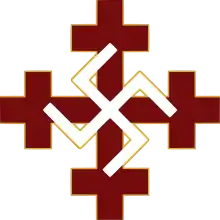Ugunskrusts
Ugunskrusts (Latvian for 'fire cross', 'cross of fire'; other names — pērkonkrusts ('cross of thunder', 'thunder cross), cross of Perun or of Perkūnas, cross of branches, cross of Laima) is the swastika as a symbol in Latvian folklore.
.svg.png.webp)

.svg.png.webp)

The swastika is an ancient Baltic thunder cross symbol (pērkona krusts; also fire cross, ugunskrusts), used to decorate objects, traditional clothing and in archaeological excavations.[1][2][3] Latvia adopted the swastika, for its Air Force in 1918/1919 and continued its use until the Soviet occupation in 1940.[4][5] The cross itself was maroon on a white background, mirroring the colors of the Latvian flag. Earlier versions pointed counter-clockwise, while later versions pointed clock-wise and eliminated the white background.[6][7] Various other Latvian Army units and the Latvian War College[8] (the predecessor of the National Defence Academy) also had adopted the symbol in their battle flags and insignia during the Latvian War of Independence.[9] A stylised fire cross is the base of the Order of Lāčplēsis, the highest military decoration of Latvia for participants of the War of Independence.[10] The Pērkonkrusts, an ultra-nationalist political organisation active in the 1930s, also used the fire cross as one of its symbols.
References
- Guénon, René (2001). The Symbolism of the Cross. Sophia Perennis. p. 62. ISBN 978-0900588655.
- "Latvia and the Swastika". latvians.com. Retrieved 2018-11-08.
- "Swastika | Latvian History". Archived from the original on 30 July 2017. Retrieved 1 July 2017.
- "Latvia – Airforce Flag and Aircraft Marking". fotw.info. Retrieved 2018-11-08.
- Lumans, Valdis O. (2006). Latvia in World War II. Fordham Univ Press. p. 39. ISBN 978-0823226276.
- Latvian Air Force 1918–1940 Archived 17 February 2012 at the Wayback Machine. Retrieved 30 September 2008.
- Spārnota Latvija Archived 2012-02-04 at the Wayback Machine. Retrieved 30 September 2008.
- "Nozīme, Apvienotā Kara skola, 1938. gada izlaidums, Nr. 937, sudrabs, Latvija, 20.gs. 20-30ie gadi, 44.3 x 34.2 mm, 15.60 g, darbnīca V. F. Millers". Vitber (in Latvian). Retrieved 2018-11-08.
- "Latvijas armijas, Nacionālo Bruņoto Spēku un citu iestāžu karogi". latvianmilitaryhistory (in Latvian). 2012-10-01. Retrieved 2018-11-08.
- "Exhibition "The Lāčplēsis Military Order" ← National History Museum of Latvia". lnvm.lv. Retrieved 2018-11-08.